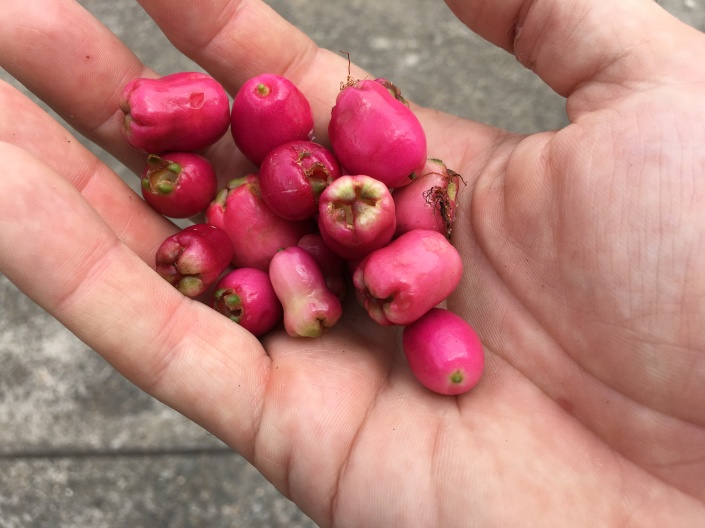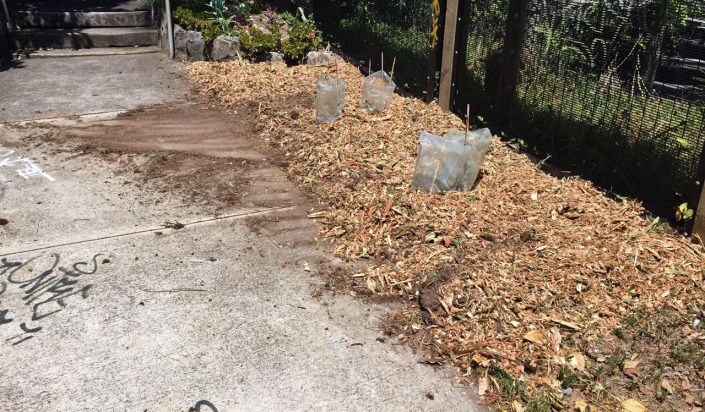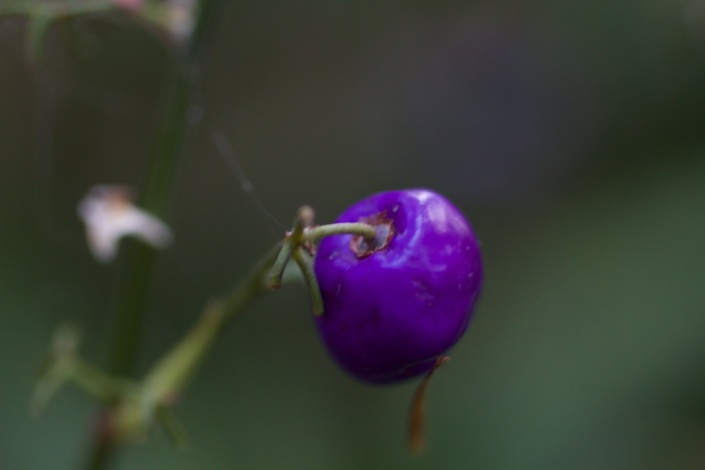Native gardens
Growing your own lilly pilly from foraged seeds
This is the season for lilly pillies (syzygium and acmena) to flower and fruit. And if you want a lilly pilly in your own garden, it’s easy: just find a local bush that has fruit you like the taste of.
The outer flesh of the fruit prevents germination, so eat that off. Then plant the seeds in some seed-raising mix. Wait and watch them grow!

We’ve found them to strike very easily and to grow vigorously. Once they get bigger, divide them into individual pots. Then transplant them into the garden when they’re ready.

These particular plants are Syzygium Leuhmanii, which have a crisp cinnamon taste. We’re growing a whole hedge of them down at the farm, from Lewisham-collected seeds 🙂

Creating an edible forest garden: the start of a 20 year journey

The big plan for our rural property is to create something called an “edible forest garden”, as described in the book by the same name by Dave Jacke and Eric Toensmeier.
This is like the “food forest” concept described in permaculture, but on steroids.
The overarching idea is to create a forest-like ecosystem, but with as many of the niches filled with food-producing plants. For example, this could consist of a:
- canopy of fruit or nut trees
- a middle layer of food-producing bushes (rainforest plants should be a good fit)
- ground layer of supporting plants, adding nutrients or attracting beneficial bugs
Contrast this to a typical orchard: the trees are carefully spaced to maximise production, but underneath there’s nothing but grass that needs to be constantly mowed. The trees themselves need constant feeding and management.
The orchard produces the most fruit, but only the fruit. The edible forest garden has more competition between plants, so the canopy produces less. But when you add up all the food produced at all the layers, it wins hands-down. Better yet, by mimicking a normal forest, only a little management is needed, and hopefully no maintenance.
Has this been done in Australia?
The original ideas come out of North America and the UK, and this is where most of the real-life examples come from. I’ve heard of a few small-scale gardens in Australia, but I suspect there’s not many in total.
So my goal is to fully explore this concept in temperate Australia, utilising native bushfoods and rainforest plants wherever possible.
The books are very heavy-weight, and the approach requires a huge amount of planning. It may be 6-12 months before even the first plant goes into the ground.
I’ll write up our journey as it progresses, starting with our goals for the edible forest garden, and then working steadily down into design details.
Give us 10-20 years, and voila, there should be an edible forest! Lucky for us it’s the journey we’re looking forward to 🙂
PS. the pair of Edible Forest Gardens books are excellent, and I’d highly recommend you get a copy if you want to take food forests to the next step…
Wattleseed scones

I recently ordered a bunch of “bush food” ingredients from Wild Hibiscus Flower Co, including ground wattleseed, ground mountain pepper, whole native pepperseeds, and whole bush tomatoes.
So with Australia Day last week, I had a hankering to use some of these wonderful native ingredients. Wattleseed scones were the first thing to come to mind.
These are a ‘classic’ bush tucker item, and I’ve heard them mentioned often. They’re also listed on the menus of many restaurants and catering companies.
But how hard was it to find a recipe! I looked through all my native food cookbooks, and spent 45mins searching on Google. I finally found a recipe buried in the middle of a Northern Rivers Landcare PDF.
I ended up varying it a bit, so here’s my version, to help others more easily find a recipe:
Wattleseed scones
150ml cream
½ cup milk
2 tbsp plain yoghurt
Mix together the wet ingredients. Add the dry ingredients, and mix, making sure you don’t overwork the batter.
Spread into a 2cm thick layer, and use cookie cutters to cut out circular scones. Place these side-by-side on a non-stick baking dish, and bake for 10-15mins in a 190°C oven, until brown.
(How were they? Delicious! The wattleseed has a distinctive flavour, almost like coffee, and we had the scones with homemade rosella jam and strawberry jam.)
Death gets in the way of life

The Lewisham House blog has been very quiet in recent months. This was due to my mother, Andrea, suddenly passing away at the end of April. At the age of 67, we had no warning, and were expecting to have her with us for many decades yet.
Mum and I had a shared passion for gardening, swapping produce, seeds, and assistance. Her large apartment had a wrap-around balcony on all four sides, packed with hundreds of plants of every type.
One of the challenges was to find a home for these plants. This ultimately turned into an opportunity for her gardening passion to live on.
Her fruit trees went into the guerrilla gardened food forest out the back. The natives went into the guerrilla gardened strip alongside the railway station. And the rainforest plants created an instant jungle behind our back fence, shown above.
It’s nice to think that these will live productively for many years, tended as carefully as she would have…
Starting a new strip of guerrilla gardening alongside the railway line

About six months ago I started planting natives beside Lewisham train station, taking the initiative where the council and railways hadn’t. That patch is growing well, although it’s constantly under threat from work vehicles which tend to drive down the pedestrian path.
So to diversify my risks, I’ve started guerrilla gardening the other end of the pedestrian way, where it meets West St. As can be seen from the photo above, it was hardly a delight for those walking by.

The starting point was to mattock over all the ground, breaking it up, and pulling out the grass and weeds. A full barrow-load of my best compost then went it to add some life back into the soil, along with a few handfuls of native-friendly fertiliser.

Marrickville Council nursery kindly maintains a pile of mulch, for free use by locals. Now that I have a ute, I took full advantage 🙂 What wasn’t used on the new strip went to supplement the existing plantings.

The result is a new strip of guerrilla gardening ready to be planted. It’s also a great way to get some exercise, as it took a fair portion of a day to get everything done.

With a week of grey rainy days ahead (in contrast to the recent heat and humidity!), I got the first plants into the ground. Most of these were cuttings from my previous plantings, but I also added a few new things that I picked up at the council nursery. This included Indigofera Australis (native indigo) and Pomaderris Intermedia, both of which should grow into attractive mid-sized bushes.
Our mini green roof is getting greener

Eighteen months ago we created a mini green roof over the far end of the chicken run. The main goal was to learn more about the practicalities of building a green roof, as adding a bit more visual interest to that corner of the garden.
It hasn’t been the easiest of journeys. Within a fortnight, the local possum ate our green roof down to the ground. The Australian weather was also punishing, even in this relatively shaded and protected spot.
The turning point was switching our planting strategy, narrowing down to two incredibly hardy plans: dianella and bracken fern. Both were transplanted from other areas of the garden, and they settled in quickly.
While it’s still got a little way to go, the photo above shows that the green roof is finally … green. Phew.
A dessert of Dianella and mixed berries

We’ve extensively planted Dianella Caerulea (Blue Flax-Lilly) throughout our native back garden, and in our verge gardens. It’s tough, drought hardy, and fast growing.
It also produces delicate blue flowers, which then grow into bright blue/purple berries.

These are a native bush food, with a pleasant, if not overly strong flavour.

I picked a good harvest of them one afternoon, supplemented by takings from our raspberry and blueberry plants.

Together, they made a delicious dessert, when combined with greek yoghurt and our own honey.
A feast for both the eyes and mouth!
Fifty plants now in around Lewisham Station

Since my early native plantings around Lewisham Station, I’ve been steadily adding to the collection, mostly by planting a few of my hand-raised cuttings each weekend.
I’ve now reached the milestone of fifty plants. These are planted closely together — typically about 30cms apart — to create a dense “bush pocket” effect.
While that might seem like a crazy amount of over-planting, it’s all to a plan:
- At the back of the strip, a canopy of small trees, including acacias (wattles) and callistomons (bottle brushes).
- A mid story of native bushes, including westringias (native rosemary), correas (native fuchsia) and prostantheras (mint bushes).
- A bottom story of strap-leaf plants at the front of the strip, and a mix of hardy groundcovers throughout the rest.
I reckon there may be 30-50 more plants required to fill it all out, but I’ll continue the slow-and-steady approach.
So far only two plants have died, and they were struggling as cuttings even before I planted them out.
Fingers crossed the rest will keep on going strong!
Our native back garden: one year on

In addition to our productive vege patches at the front of the house, we established a native garden in the back.
A year on, the garden is growing solidly, although it still has some way to go until it creates the “mini bush block” effect we’re looking for…
What’s grown well: the correas (of many types), lomandras and dianellas. The backhousia citriodora (lemon myrtle) also grew quickly towards the light.
What didn’t: the boronias all died at various points (ok, ok, so absolutely everyone told me that would happen!). We’ve also had the usual assortment of random deaths over the last year.
Considering the garden has dappled shade, with big trees growing on adjacent properties, I think we’re doing pretty well.
And to highlight the point, this was the before shot, from a year ago:

A natural home for native stingless bees
We’ve had native stingless bees for several years now, and they live very happily in their small home, complete with a tin roof.
When we visited Sydney’s botanic gardens a few weekends ago, we were very impressed with their super-natural home for bees:

I’m reliably told that the hive on the right is currently empty, awaiting an enthusiastic swarm from the active hive to populate it. Which only leaves the question: how did they get the bees into the first hive?
I’d love to have this sort of log home for our native bees, so I’ll ask around to find out more…